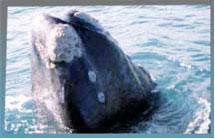Southern Right Whale Behaviour
Southern Right Whales are easily distinguished from the other 2 baleen whales ( Humpback & Bryde’s whales ) by three distinct characteristics: V-shaped blow, callosities on their heads and the lack of a dorsal fin on their broad backs. They visit the South African Coast from June- December.
Southern Right Whales can reach a maximum length of 15-17 meters and can weigh 50 – 60 tons. They have broad black tails and squarish flippers.
Southern Right Whale Behaviour:
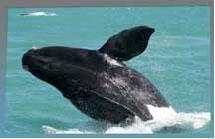 Breaching:
Breaching:
Periodically a whale may thrust three-quarters or more of its body out of the water, pivot onto its side and back, and fall back with an enormous splash into the sea. This jumping technically known as “breaching”’ frequently occurs several times in succession. This behavior might be a form of communication or indication of male prowess, generally during mating. Or it might be to get rid of whale lice or perhaps the activity assists in the moulting process and maybe they do it for the pure fun of it. It is usually done in sets of between four and six. When performed by young calves, for instance, it seems that the activity is one of sheer exuberance. This is undoubtedly the most spectacular of all whale behaviour.
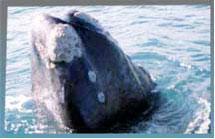 Spy hopping:
Spy hopping:
This term was known by the whalers as whales lift their heads and part of their bodies out of the water vertically to give them a 360 degree view of the world above the water and may be that the whale is observing its surroundings as they are most curious.
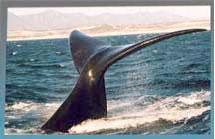 Lob tailing:
Lob tailing:
This is an activity in which the animal sticks its tail out of the water, swings it around and then slaps it onto the water’s surface causing a shower of spray. This produces a loud sound which is believed to be a means of communication between whales or a warning of rival whales, sharks, annoyance or mild threat. This may be done repeatedly over long periods.
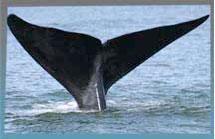 Sailing: (Tail)
Sailing: (Tail)
Occasionally whales lift their tails clear of water for long periods. The tail is held aloft for an extended period of time, like a giant black butterfly. They turn their tales to get the advantage of the wind, much like a sail in the wind. This could mean catching wind to ‘sail’ through the water or a way of cooling down. Another view is that this represents a form of temperature control for the body, either through solar radiation or evaporative cooling as the blood vessels in the tail form a counter current system much like a radiator. A third option is that the whale is feeding on organisms close to the sea-floor.
Fluking:
When a whale raises its tail out of the water as it begins a dive.
Grunting:
A loud, bellowing sound that carries up to two kilometers away. Often heard during the night.
Southern Right Whale Facts:
- Type: Mammal
- Diet: Carnivore
- Size: 50 ft (15.25 m)
- Weight: 70 tons (63.5 m tons)
- Group name: Pod
- Protection status: Endangered
- Females produce calves on average once every three years.
- Southern Right calves drink almost 600 litres of milk per day while sucking.
- Southern Rights were the first of the large whales to be protected in 1935.
- Southern Rights dive to a maximum depth of about 300 meters.
- Lifespan of the Southern Right Whale is estimated between 70 - 100 years
Whale Watching in Hermanus
Call us and schedule your listing today! Contact Us
Copyright © 2025 Hermanus Online Magazine. Web Development by Jaydee media.


